Shaping Story Structures: A Guide for Writers
Every story, regardless of its medium or genre, has a structure. This is the backbone that gives your story form and coherence. It’s what makes your characters come alive on the page and drives the plot forward.
But what is story structure? How do you go about shaping your own story? And how can you use different structures to enhance your writing?
In this article, we’ll explore different types of story structures and discuss how to use them to create powerful narratives. So if you’re looking for a guide to help you shape your writing, look no further.
- Introducing Story Structure
- Why is it important for writers to understand Story Structure?
- The Elements of a Story Structure
- The different types of story structures
- Classic Story Structure
- Three-Act Structure
- The Hero’s Journey
- Seven Point Story Structure
- The Story Circle
- Fichtean Curve
- Freytag’s Pyramid Structure
- How to use story structure to create powerful narratives?
- Examples of well-known stories that use different types of story structure
Introducing Story Structure
Have you ever been mesmerized by a story, so much so that the entire thing seemed to be perfectly crafted? Ever wonder how it’s made that way? Story structure is the answer. It is the narrative architecture that dictates how stories are constructed and presented to their audiences.
It balances story mechanics with story emotion and creates cohesion between story components such as characters, plot devices, conflicts, and themes. Without it, stories lack focus and clarity and will often fail to captivate readers or viewers.
Understanding story structure is an integral part of storytelling and can make the difference between an engaging story and one that’s forgettable.
Why is it important for writers to understand Story Structure?
Having a deep understanding of story structure can unlock incredible potential for writers. It gives them the tools to craft engaging stories that draw readers in and create a sense of suspense or mystery.
Additionally, the understanding of structure provides writers with an essential platform from which to launch their creativity; by understanding the structure and pacing of their options, they have the freedom to establish a strong plot with meaningful characters that ultimately captivate their audience.
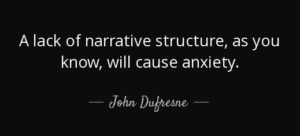
To begin, the structure allows writers to think critically about how each element must function within the narrative, empowering them to create stories that exceed expectations for reader engagement.
Ultimately, understanding story structure in creative writing is crucial for writers because it helps them to develop detailed narratives filled with intriguing moments and memorable characters.
The Elements of a Story Structure
Every story has a structure to engage its readers. A story structure is composed of several elements necessary to move the story along.
The status quo is an important element of story structure that shapes the story’s world and events. It helps create normalcy and constancy that the story can use to measure changes against and track character progression. When characters or events in stories go from one state to another, it creates tension as the new state is set in contrast with what previously existed.
Without the status quo, the story structure would be lacking depth and nuance. An effective story structure creates an environment where characters have space to grow and progress – something the status quo makes possible. Through these methods, storytellers apply consistency while still driving the action forward to keep readers engaged in their story’s journey.
The status quo is disrupted by a crucial element known as the inciting incident, which is the event that sets off the story and provokes a response from the protagonist – it’s their call to action.
The next element is exposition, this includes introducing important characters, setting up the story, and providing some backstory if necessary. After this comes rising action, which is where all of the conflicts arise as well as any subplots developing within your story.
Finally, we reach climax – this is where all of these tensions rise and conflict to bring forth a resolution before leading into the conclusion of your story; tying together all story elements developed throughout. These denote what we know as structure and will always remain an integral part when crafting creative stories with engaging characters.
The Different types of Story Structures
The narrative structure is the framework with which stories are crafted. Understanding narrative structure in fiction writing gives writers a better idea of how to shape their narrative in a way that will draw readers in and keep them engaged. There are specific types of story structure we will delve into to understand the varied forms narrative structure can take.
Classic Story Structure
At its core, the classic story structure is a framework for creating story arcs and plots. Popularized by American author Dean Koontz, the classic structure follows a simple but effective formula that can be used to create captivating stories.
The story arc begins with the main character’s introduction, followed by a build-up in tension and stakes leading to a climax where all of the story’s questions and conflicts are resolved.
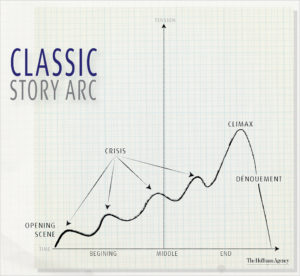
Throughout this structure, the main character confronts obstacles and learns lessons that shape their journey toward their ultimate goal.
This classic structure offers an organizing principle to keep narrative stories easily readable and engaging for readers, making it one of the most popular story models for authors today.
Three-Act Structure
The three-act structure is a way of organizing stories into three distinct sections. Each act is intended to be unique and serves a purpose in the development of the narrative. The first act introduces the setting, characters, and general conflict that will be explored throughout the story.
The second act contains increasing tension and greater opposition as the characters clash against one another, leading towards some sort of climax at the end of this middle act. The third act resolves all plot lines and leads up to the ultimate resolution.
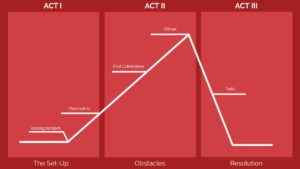
Several famous works have utilized the three-act structure with great effects, such as Shakespeare’s Romeo & Juliet which follows three families in conflict, leading to a tragic resolution or Lord Of The Rings which progresses from an initial challenge for Frodo, through numerous conflicts until finally reaching a victorious ending.
The Hero’s Journey
Joseph Campbell’s the Hero’s Journey has become the iconic structure for many of the most successful works of literature in the modern age. By recognizing the cycles and stages of the journey, this timeless narrative formula provides a structure for writers to create captivating stories that draw in audiences and keep them invested.
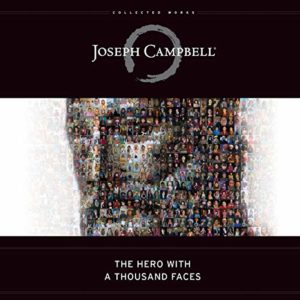
It follows the traditional monomythic tropes from the oldest metanarrative, which are passed down from generation to generation, while also allowing space for them to be adapted uniquely in each new story.
The Hero’s Journey is a powerful storytelling device that helps writers engage readers in an exciting journey and unwind the hero’s transformation before their eyes.
An Ordinary World
The ordinary world is the first step in the hero’s journey. It marks the start of the hero’s story and sets the stage for their adventure. Often, the ordinary world is portrayed as the hero’s comfort zone, a place they feel safe and content.
It constitutes all the familiar aspects of the hero’s life before the initiatory call to adventure and is full of daily routine and predictable experiences, providing the contrast between the “ordinary” and the extraordinary that will come during the initiation.
While an ordinary world does not have to be perfect – it can contain elements of darkness or hierarchy – it is a place where the explorer feels secure enough to take risks when invited. Ultimately, an ordinary world sets a baseline from which transformation can begin once the hero decides to embark on the initiation they were offered.
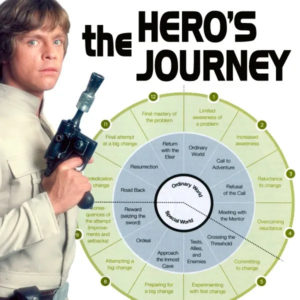
A Chosen Call
The hero’s journey is a staple in the realm of the mythical and the spiritual, and the call for adventure is the cornerstone of the story. It begins with the hero, often viewed as the chosen one, being summoned from his everyday life to pursue a greater purpose and ultimately an epic quest.
This call for adventure can take many forms- an invitation from a higher being or mentor, the discovery of secret knowledge, or the drive to fulfill an ancient prophecy. The stakes often skyrocket in these moments as the hero is challenged to accept the unknown and realize their true potential as the lead protagonist in this otherworldly journey.
Ultimately, answering the call for adventure sets them on the path of transformation and glory that awaits them at the end of their quest.
Refusal
When the main character hears the call and begins to consider their destiny, they must often confront the fear, hesitation, and trepidation that can come with the refusal of the call. The doubt and insecurity the hero feels when faced with the immense challenges ahead can cause them to deny the task and reject the opportunity completely.
The refusal of the call is a reminder that sometimes it is easier to stay within our comfort zone rather than embark on an unpredictable adventure filled with risk. Despite these moments of hesitation, the force of destiny pushes forward regardless. The power of the call will inevitably lead the hero on the next step of their journey despite any attempts at rejection.
The Mentor
The trope of the hero’s journey typically features the main character meeting a mentor at a crucial turning point in the story. This character is often wise and experienced, serving as the hero’s guide and teacher through their journey of transformation.
The mentor-protege relationship is essential in the growth and development of the hero, providing them with the guidance they need to overcome the challenge they are facing.
Mentorship is often characterized by sharing wisdom from the mentor’s own past experiences or knowledge that otherwise could not be accessed, putting the events into context for the hero.
In this sense, mentorship serves to amplify the hero’s skills, making them more powerful and resilient in their pursuit of success against all obstacles.
It is through this pivotal role that mentors continue to empower heroes such as Bilbo Baggins, Luke Skywalker, King Arthur, and many others throughout mythology and literature throughout time.
Venturing beyond the threshold
Crossing the threshold marks the point of no return for the hero. This is the point the hero ventures beyond his or her comfort zone and marks the beginning of the exciting journey ahead.
Crossing the threshold requires the hero to leave the world he knew and enter a new, unfamiliar world. The transition often includes a literal or figurative gateway that either needs to be opened or crossed by the hero to venture into this new world. quest and fulfill their destiny.
Allies and Enemies
This phase involves the ultimate test of the protagonist’s courage and resilience, as the outcome depends on the allies the hero forms along the way. From teachers to helpful helpers, the hero can find friends who support him in the journey, provide him with the necessary instructions or tools to succeed, or act as a mentor and role model for success.
On the other hand, enemies come in the form of antagonists and adversaries— villainous figures obstructing the protagonist from completing their goals. These enemies may be physical or psychological.
Approach to the inmost cave
The approach to the inmost cave is an internal journey the hero must embark upon. This is the true test of conviction and bravery for the hero must be willing to make a great sacrifice, whether emotional, mental, or physical.
At this moment, it is easy for the hero to succumb to defeat but instead, they choose to risk everything for the greater good. The ultimate goal is to reclaim what was lost along the way: identity and purpose.
The Ordeal
The ordeal is the moment the protagonist steps out of the regular world and into the unknown. It’s the most intense stage of the entire journey, presenting the hero with obstacles, tests, and profound challenges.
During this stage, the protagonist is often confronted with a physical or metaphorical death. Amid his or her darkest hour, the fictional character experiences an emotional breakdown that leads to a series of self-discoveries and personal growth ordeal can be likened to a rite of passage that ultimately leads to renewal and enlightenment.
The Reward
A key feature of the hero’s journey is the reward at the end, a crucial element in engaging readers and making the journey a satisfying one. This reward takes many forms and often provides the catalyst for the transformation or redemption of the protagonist, frequently prompted by an epiphany or other realization during their adventures.
The Resurrection
The resurrection is the climax and the point where the hero undergoes the most dramatic transformation. It is the stage when our protagonists have accepted the challenge they are facing, have taken control of the situation, and have embraced their destiny.
Symbolically speaking, the resurrection is the moment of rebirth when the hero resurrects from a broken or false sense of self to their true identity and finds their inner strength.
Return with the elixir
The return with the elixir is a pivotal moment, representing the hero’s successful completion of the task at hand and triumphant return home. On the journey, the hero has faced challenges and obstacles that have changed them in some way.
They have gained knowledge, wisdom, or insight that can be used to benefit their community in the form of the elixir.
Seven-Point Story Structure
The seven-point story structure is a powerful tool for creating compelling narratives.
It has seven distinct components, beginning with the hook, which grabs readers’ attention and draws them into the story. From there, comes plot point one, which introduces the characters and their conflicts.
Pinch point one serves to heighten tension and keep readers on their toes as the story progresses. Midpoint brings in a new element to turn the conflict in an unexpected direction and create even more suspense.
Then we have pinch point two, taking readers further down the rabbit hole of unpredictable events that must be solved before they reach the climax at plot point two.
The resolution is ultimately what ties everything together into a satisfying conclusion that brings an end to the conflict and wraps up all loose ends. By following this seven-point structure throughout your writing process, you can easily work towards telling an engaging story every time!
The Story Circle
A story circle is a structural framework devised by Dan Harmon to help storytellers understand and develop meaningful story arcs.
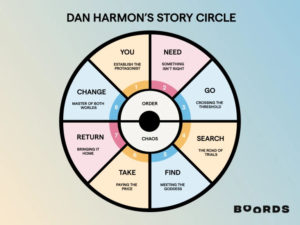
The story circle consists of eight steps that the protagonist goes through in an archetypal story: an introduction, development of a problem, attempts to solve the problem, complicating action, a seemingly unavoidable defeat or setback, the pursuit of an alternative strategy or plan of attack, a climax where the plan succumbs to mounting pressure and tension, then finally a resolution of the conflict.
This cyclical structure is often repeated throughout different forms of stories such as novels, movies, and plays, and has been helpful for authors looking to craft engaging stories.
Fichtean Curve
John Gardner, the prolific author, and theorist proposed the Fichtean curve type of story structure in his book The Art of Fiction.
This type of narrative is composed of a central crisis or dilemma for the protagonist that usually occurs near the beginning of the story; then tension mounts until finally there is a mini-crisis before the bigger problem is ultimately resolved.
Gardner saw this dynamic as an extended curvilinear shape: rather than rise to a climax and then decline gradually, tension increases and decreases in related but disparate arcs. His Fichtean structure emphasizes that when a mini-crisis occurs, it must be directly related to the larger story’s central conflict, or else it will rob readers of much-needed narrative tension. The Fichtean Curve structure of storytelling can be further broken down into three different components:
Rising Action
Rising action focuses on developing the protagonist’s dilemma and introducing complicating elements; such as additional characters as obstacles or conflicts.
Climax
The climax is the moment when the story reaches its highest intensity – where the stakes are at their peak and the conflict is resolved in some way.
Falling Action
Lastly, we have falling action which demonstrates how our protagonist exits from their conflict and continues with their journey.
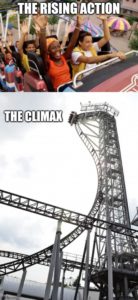
Through this structure of storytelling, Fichtean curves provide an engaging narrative arc tasked with maintaining suspense while keeping readers invested in the story until its conclusion.
Freytag’s Pyramid Structure
Freytag’s Pyramid structure is a five-point structural model proposed by German playwright Freytag to explain the conclusion of storylines. Freytag was inspired by the structures of classical Greek Tragedies, so this five-point structure is also known as Freytag’s dramatic arc or Freytag’s dramatic curve.
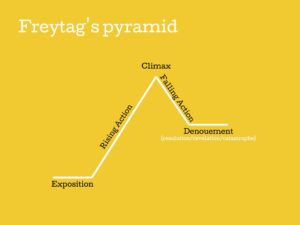
This pyramid structure consists of a hook and introduction at the beginning, rising action in the middle, climax at the top, falling action comprised of denouement, and resolution at the end.
The Hook
At the base of Freytag’s pyramid, is the introduction, or “hook,” as it is more commonly referred to. This hook begins the story by introducing an aspect that will draw in and captivate readers. It does this by employing an evocative opening scene, an intriguing character and/or situation, surprise initiating the storytelling; all these facets uniting to convey and draw interest from the reader.
Freytag asserted that without a good hook at the start of your story there is no compelling reason for anyone to continue reading. A well-crafted hook creates tension and anticipation that only serves to rivet readers more for what will unfold.
Rising Action
In Freytag’s structure, the rising action is perceived as an important element and holds an essential role in developing the story. It presents tension, establishes conflict, and builds excitement and suspense as it leads to the climax of the story, where all conflicts are resolved.
The upward climb of the rising action steadily escalates until it reaches its peak at the climax where all struggles come to a head.
Climax
Freytag’s Pyramid story structure is a classic model of narrative that emphasizes the climax as a crucial concept. This refers to the moment when past events, decisions, and choices culminate into an unavoidable conclusion, leading protagonists to their fates – there is no return after the climax.
Freytag’s pyramid structure includes plot points that build toward the climax and lead to some form of resolution afterward.
Denouement
Central to Freytag’s storytelling approach is the concept of denouement – a French term meaning ‘the untying of the plot’. Within Freytag’s framework, the denouement follows the climax and builds towards a resolution for lingering questions created in previous parts of the story.
Resolution
In Freytag’s story structure, resolution involves addressing any conflicts faced by the protagonist, often answering the original questions posed at the beginning. It also reinforces a theme, morals, or message to emphasize a takeaway for readers.
This type of structure has become highly popular in modern stories and movies, where writers and directors use Freytag’s Pyramid strictly or with subtle alterations to construct stories that span multiple chapters/sequels or can be concluded into one movie. Freytag’s Pyramid goes to show how even though there are many ways to tell a story, some narrative techniques never go out of style.
How to use story structure to create powerful narratives?
Story structure is one of the most important elements to consider when creating powerful narratives. By using story structures, writers can guide the audience on a story journey that keeps them engaged and entertained, while suggesting themes and ideas throughout. Some story structures are more straightforward and include linear progression, while others are more complex such as a release arch or a hero’s journey.
These story arcs keep readers interested because of the suspense that builds as the story progresses leading up to its resolution. The rich structure also gives writers potential opportunities to insert symbolism into stories, tying deeper meaning within every element.
Writing with a structure in mind allows writers to create an experience for their readers by taking them on an emotional journey, helping professional writers create powerful impactful works of fiction.
Examples of well-known stories that use different types of story structure
The Classic Story Structure
One of the most famous stories that follow the classic story structure is Harper Lee’s To Kill a Mockingbird. As with many classic stories, it follows a narrative structure of exposition, rising action, climax, and resolution.
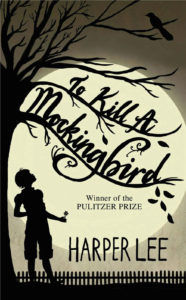
This story certainly has all these components; for example, the exposition gives us an insight into the characters and their world and the story builds up as events such as Scout bringing in Walter Cunningham to dinner introduce tension. Despite being set in the mid-twentieth century American South, this story remains remarkably topical, resonating with readers all around the world.
The Hero’s Journey
A great example of this story structure being utilized is that of the classic story Star Wars and its hero, Luke Skywalker. Luke’s story starts with him living on a desolate planet and facing struggles from an oppressive government.

After overcoming numerous difficulties and finding allies to help him out along his journey, he eventually faces his ultimate challenge: confronting Darth Vader in a battle for the fate of the galaxy.
Through trial and error, and ultimately having to trust himself, Luke can destroy the Death Star and fulfill his hero’s journey – resulting in him becoming a legend across multiple galaxies.
The Story Circle
A story that is known for its cyclical story structure—or story circle structure—is the ancient Greek tragedy “Oedipus Rex” by Sophocles. In this story, the story expands from a single event and gradually circles back around to the same event, making it a powerful example of story circle structure.

Oedipus’s tragic flaw leads him from comfort, success, and power to horror and self-knowledge as he completes his journey to acceptance. While Oedipus was not aware of his fate in the beginning, through his story journey, he comes to learn that even in our darkest moments when we think we’re alone, there is an element of understanding revealed once you accept your life story.
In this blog post, we have examined the different types of story structures, from three-act structures to Freytag triangles. We have identified ways to use each structure for optimal success in both long and short-form works.
At the end of the day, feel free to experiment and find a structure that fits your creative process. With practice and trial & error, your writing can become captivating journey readers will want to experience again and again.

